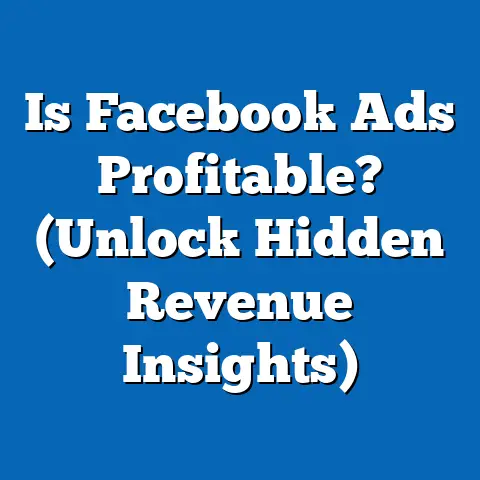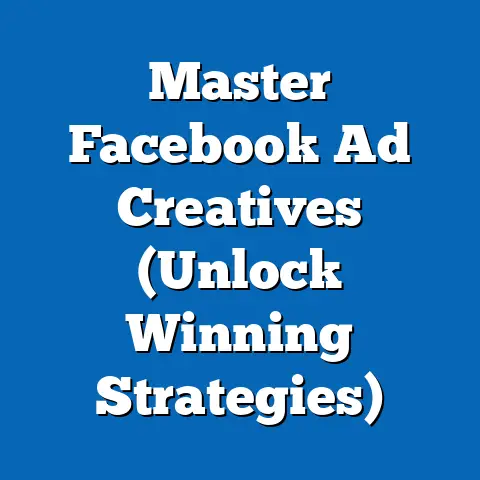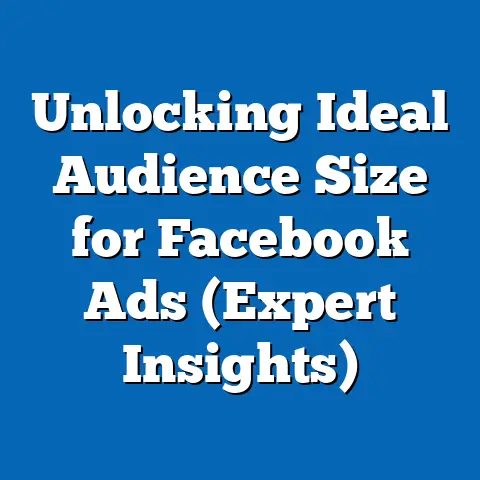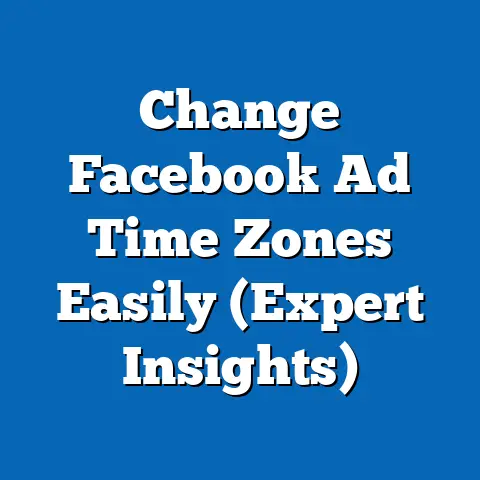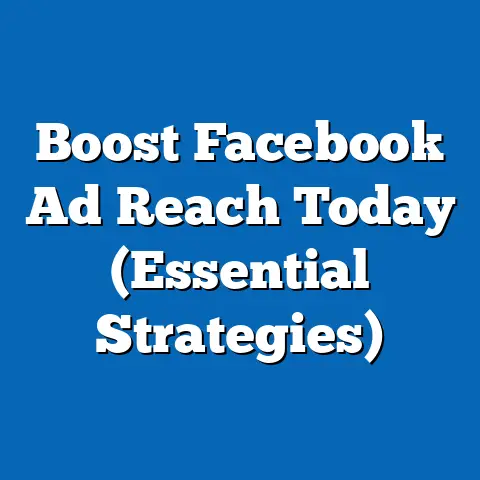Unlock Facebook Ad Promotion Costs (Smart Budgeting Insights)
Have you ever felt overwhelmed by the rising costs of Facebook ads and wondered how to effectively budget for them? If you have, you’re not alone. I’ve been there, staring at the Ads Manager, feeling like my marketing budget was disappearing into a black hole. The truth is, navigating Facebook ad costs can be tricky, but with the right knowledge and strategies, you can absolutely make your budget work for you.
In this guide, I’m going to walk you through the ins and outs of Facebook ad budgeting, sharing insights I’ve gained from years of experience managing campaigns for businesses of all sizes. We’ll break down the different cost components, explore smart budgeting strategies, look at tools that can help, and even delve into real-world case studies. My goal is to equip you with the confidence and knowledge to tackle your Facebook advertising challenges head-on.
Section 1: Understanding Facebook Ad Costs
Before we dive into budgeting strategies, it’s crucial to understand the fundamentals of Facebook ad costs. It’s not just about throwing money at the platform; it’s about understanding how your money is being spent and what you’re getting in return.
Decoding the Acronyms: CPC, CPM, and CPA
These acronyms are the language of Facebook advertising costs, and understanding them is essential.
- CPC (Cost Per Click): This is the amount you pay each time someone clicks on your ad. It’s a good metric to track if your goal is to drive traffic to your website or landing page.
- CPM (Cost Per Mille): “Mille” means thousand in Latin. CPM is the amount you pay for every 1,000 impressions your ad receives. An impression is simply when your ad is shown to someone. CPM is useful for brand awareness campaigns where the goal is to get your ad seen by as many people as possible.
- CPA (Cost Per Acquisition): This is the amount you pay for each conversion, whether it’s a sale, a lead, or an app install. CPA is the holy grail for many advertisers because it directly ties ad spend to business results.
Why are these important?
Understanding these metrics allows you to:
- Evaluate campaign performance: Are you paying too much per click? Is your cost per lead sustainable?
- Compare different campaigns: Which ad sets are delivering the best results at the lowest cost?
- Make data-driven decisions: Adjust your targeting, ad creative, or bidding strategy based on real-time data.
The Auction System: How Facebook Determines Ad Costs
Facebook uses an auction system to determine which ads are shown to users and how much advertisers pay. It’s not just about who has the highest bid. Facebook also considers the quality and relevance of your ad. Here’s how it works:
- Bidding: You tell Facebook how much you’re willing to pay for a specific outcome (e.g., a click, an impression, a conversion).
- Auction: When a user is eligible to see an ad, Facebook holds an auction among all advertisers targeting that user.
- Winning Ad: The ad with the highest total value wins the auction. Total value is calculated based on:
- Bid: Your maximum bid for the desired outcome.
- Estimated Action Rate: Facebook’s prediction of how likely the user is to take the desired action (e.g., click, convert).
- Ad Quality & Relevance: How relevant and engaging Facebook thinks your ad is to the user.
- Bid: Your maximum bid for the desired outcome.
- Estimated Action Rate: Facebook’s prediction of how likely the user is to take the desired action (e.g., click, convert).
- Ad Quality & Relevance: How relevant and engaging Facebook thinks your ad is to the user.
My experience with the auction system:
I remember one campaign where I was consistently outbid by competitors, even though my bids were relatively high. I realized my ads weren’t as engaging as theirs. I revamped my ad creative with more compelling visuals and copy that spoke directly to my target audience’s pain points. Suddenly, my ads started winning more auctions, and my costs came down significantly.
Key Takeaway: Don’t just focus on bidding; optimize your ad quality and relevance to increase your chances of winning the auction at a lower cost.
Factors Influencing Facebook Ad Costs
Many factors can influence your Facebook ad costs. Here are some of the most important:
- Audience Targeting: The more specific and niche your audience, the higher the cost. Broad audiences are cheaper but may not be as effective.
- Ad Placement: Ads placed in more desirable locations (e.g., Facebook News Feed) tend to be more expensive than those placed in less visible areas (e.g., Audience Network).
- Ad Quality & Relevance: As mentioned earlier, high-quality, relevant ads are rewarded with lower costs.
- Bidding Strategy: Different bidding strategies (e.g., lowest cost, target cost, cost cap) can impact your costs.
- Seasonality: Ad costs tend to increase during peak seasons like holidays and major shopping events due to increased competition.
- Industry: Some industries (e.g., finance, insurance) are inherently more competitive and have higher ad costs.
- Ad Objective: Certain objectives (e.g., conversions) tend to be more expensive than others (e.g., reach).
Practical tip:
Test different targeting options, ad placements, and bidding strategies to find the optimal combination for your specific campaign goals and budget. Don’t be afraid to experiment and iterate.
Next Steps:
- Familiarize yourself with the key cost metrics: CPC, CPM, and CPA.
- Understand how the Facebook auction system works and how it impacts your ad costs.
- Identify the factors that influence your ad costs and start experimenting with different options.
Section 2: Breaking Down Your Advertising Budget
Now that we understand the factors influencing ad costs, let’s talk about how to break down your advertising budget effectively. A well-structured budget is essential for maximizing your ROI and achieving your marketing goals.
Setting a Monthly or Weekly Budget
The first step is to determine your overall budget. Should you set a monthly or weekly budget? It depends on your business and campaign goals.
- Monthly Budget: A monthly budget provides a broader view of your spending and allows for more flexibility. It’s ideal for campaigns with long-term goals or those that require consistent investment over time.
- Weekly Budget: A weekly budget offers more granular control and allows you to quickly adjust your spending based on performance. It’s ideal for campaigns with short-term goals or those that require frequent optimization.
My preferred approach:
I typically prefer to start with a monthly budget and then break it down into weekly increments. This allows me to monitor performance closely and make adjustments as needed without completely overhauling my overall strategy.
How to determine your budget:
There’s no one-size-fits-all answer, but here are some factors to consider:
- Business Goals: What are you trying to achieve with your Facebook ads? Brand awareness? Lead generation? Sales? The more ambitious your goals, the larger your budget may need to be.
- Target Audience: How large is your target audience? The larger your audience, the more impressions you’ll need to reach them effectively.
- Industry Benchmarks: Research industry benchmarks for Facebook ad spend to get a sense of what other businesses in your niche are spending.
- Historical Data: If you’ve run Facebook ads in the past, analyze your historical data to understand your average costs and ROI.
- Profit Margins: Ensure your ad spend is sustainable based on your profit margins. You don’t want to spend more on advertising than you’re earning in revenue.
Example:
Let’s say you’re a small e-commerce business with a goal of generating 100 sales per month. You know that your average order value is $50 and your profit margin is 20%. That means you earn $10 in profit for each sale. To generate 100 sales, you’ll need to earn $1,000 in profit. Therefore, you can afford to spend up to $1,000 on Facebook ads per month.
Considering Overall Marketing Expenses
It’s important to remember that your Facebook ad budget is just one piece of the marketing puzzle. You also need to consider other expenses, such as:
- Creative Development: The cost of creating engaging visuals and compelling copy.
- Campaign Management: The time and effort required to set up, monitor, and optimize your campaigns.
- Software & Tools: The cost of any software or tools you use to manage your Facebook ads.
- Landing Page Optimization: The cost of creating and optimizing landing pages to convert traffic into leads or sales.
Practical tip:
Allocate a portion of your overall marketing budget to Facebook ads, but don’t neglect other important areas like content marketing, email marketing, and SEO. A well-rounded marketing strategy is more likely to deliver sustainable results.
My experience with marketing expenses:
Early on, I made the mistake of focusing solely on ad spend and neglecting the importance of high-quality creative. My ads were driving traffic, but my conversion rates were terrible. I realized I needed to invest more in professional-looking visuals and compelling copy that resonated with my target audience. Once I made that investment, my conversion rates skyrocketed, and my overall ROI improved significantly.
Key Takeaway: Don’t underestimate the importance of investing in high-quality creative and campaign management. It’s not just about the amount you spend; it’s about how you spend it.
Next Steps:
- Determine your overall Facebook ad budget based on your business goals, target audience, and industry benchmarks.
- Decide whether a monthly or weekly budget is more appropriate for your campaigns.
- Consider all your marketing expenses, including creative development, campaign management, and software.
Section 3: Smart Budgeting Strategies
Now that you have a basic understanding of Facebook ad costs and how to break down your budget, let’s explore some smart budgeting strategies that can help you maximize your ROI.
Percentage of Revenue Method
This method involves allocating a percentage of your revenue to ad spend. It’s a simple and straightforward approach that ensures your ad budget is aligned with your business performance.
How it works:
- Determine the percentage of revenue you’re willing to allocate to ad spend. This percentage will vary depending on your industry, profit margins, and growth goals.
- Calculate your monthly revenue.
- Multiply your monthly revenue by the percentage you determined in step 1. This is your monthly ad budget.
Example:
Let’s say you’re a SaaS company with a goal of allocating 10% of your revenue to ad spend. Your monthly revenue is $50,000. Therefore, your monthly ad budget is $5,000.
Pros:
- Simple and easy to implement.
- Ensures your ad budget is aligned with your business performance.
- Scalable as your revenue grows.
Cons:
- May not be suitable for businesses with low or inconsistent revenue.
- Doesn’t take into account specific campaign goals or opportunities.
Goal-Oriented Budgeting
This method involves setting budgets based on specific campaign objectives, such as brand awareness, lead generation, or sales. It’s a more strategic approach that ensures your ad spend is focused on achieving specific results.
How it works:
- Define your campaign goals. What do you want to achieve with your Facebook ads?
- Determine the cost per acquisition (CPA) for each goal. How much are you willing to pay for a lead or a sale?
- Calculate the total budget required to achieve each goal. Multiply the CPA by the number of leads or sales you want to generate.
Example:
Let’s say you’re a real estate agent with a goal of generating 50 leads per month. You’re willing to pay $20 per lead. Therefore, your monthly ad budget is $1,000.
Pros:
- Ensures your ad spend is focused on achieving specific results.
- Allows you to prioritize campaigns based on their potential ROI.
- Provides a clear framework for measuring campaign performance.
Cons:
- Requires accurate data on CPA and conversion rates.
- May be difficult to implement for campaigns with intangible goals like brand awareness.
Testing and Optimizing Budgets
No matter which budgeting strategy you choose, it’s essential to test and optimize your budgets regularly. This involves:
- A/B Testing: Experimenting with different budget levels to see which delivers the best results.
- Analyzing Performance Metrics: Tracking key metrics like CPC, CPM, CPA, and conversion rates to identify areas for improvement.
- Adjusting Budgets: Increasing or decreasing budgets based on performance data.
My experience with A/B testing:
I once ran a campaign where I tested two different budget levels: $50 per day and $100 per day. I found that the $100 per day budget generated significantly more leads, but the cost per lead was also higher. After analyzing the data, I realized that the $50 per day budget was more efficient in terms of ROI. I reduced my budget to $50 per day and saw a significant improvement in my overall campaign performance.
Practical tip:
Use Facebook’s A/B testing feature to compare different budget levels and bidding strategies. Pay close attention to your performance metrics and make adjustments as needed.
Key Takeaway: Don’t set your budget and forget about it. Continuously test, analyze, and optimize your budgets to maximize your ROI.
Next Steps:
- Choose a budgeting strategy that aligns with your business goals and resources.
- Set up A/B tests to compare different budget levels and bidding strategies.
- Analyze your performance metrics regularly and make adjustments as needed.
Section 4: Tools and Resources for Budget Management
Managing your Facebook ad budget effectively requires the right tools and resources. Here are some of the most useful:
Facebook Ads Manager
Facebook Ads Manager is the primary tool for managing your Facebook ad campaigns. It provides a comprehensive overview of your spending, performance, and targeting options.
Key features:
- Budget Setting: Set daily or lifetime budgets for your campaigns and ad sets.
- Performance Tracking: Track key metrics like CPC, CPM, CPA, and conversion rates.
- Reporting: Generate detailed reports on your campaign performance.
- A/B Testing: Set up A/B tests to compare different budget levels, bidding strategies, and targeting options.
- Budget Optimization: Use Facebook’s budget optimization features to automatically allocate your budget to the best-performing ad sets.
My experience with Facebook Ads Manager:
I use Facebook Ads Manager every day to monitor my campaigns, track performance, and make adjustments as needed. It’s an essential tool for any Facebook advertiser.
Practical tip:
Take the time to learn all the features of Facebook Ads Manager. It’s a powerful tool that can help you manage your budget effectively and maximize your ROI.
Analytics Tools
In addition to Facebook Ads Manager, there are many other analytics tools that can help you track your spending and performance. These tools provide more in-depth insights and can help you identify areas for improvement.
Examples:
- Google Analytics: Track website traffic and conversions from your Facebook ads.
- Supermetrics: Pull data from Facebook Ads Manager and other marketing platforms into a single dashboard.
- Tableau: Visualize your Facebook ad data and create custom reports.
Practical tip:
Integrate your Facebook Ads Manager data with Google Analytics to get a more complete picture of your campaign performance.
Third-Party Platforms
There are also many third-party platforms that can help you manage and optimize your Facebook ad budgets. These platforms offer a variety of features, such as:
- Budget Pacing: Automatically adjust your bids to ensure you don’t overspend your budget.
- Rule-Based Optimization: Set up rules to automatically pause or adjust your campaigns based on performance data.
- Reporting & Analytics: Generate detailed reports on your campaign performance and identify areas for improvement.
Examples:
- AdEspresso: A popular platform for managing and optimizing Facebook ad campaigns.
- Smartly.io: A more advanced platform for enterprise-level advertisers.
- Revealbot: Automates Facebook ad management with AI-powered rules.
Practical tip:
Consider using a third-party platform if you’re managing a large number of Facebook ad campaigns or if you need more advanced features than Facebook Ads Manager provides.
Key Takeaway: The right tools and resources can make a big difference in your ability to manage your Facebook ad budget effectively. Experiment with different options and find the ones that work best for you.
Next Steps:
- Familiarize yourself with the features of Facebook Ads Manager.
- Integrate your Facebook Ads Manager data with Google Analytics.
- Explore third-party platforms to see if they can help you manage and optimize your budgets.
Section 5: Real-World Case Studies
Let’s take a look at some real-world examples of businesses that successfully managed their Facebook ad budgets.
Case Study 1: E-commerce Business
Industry: E-commerce
Goal: Increase online sales
Budgeting Strategy: Goal-oriented budgeting
Challenge: High competition and rising ad costs
Solution:
- Targeted Audience: The business focused on targeting a very specific niche audience with highly relevant ads.
- High-Quality Creative: They invested in professional-looking visuals and compelling copy that resonated with their target audience.
- A/B Testing: They A/B tested different ad formats, targeting options, and bidding strategies to find the optimal combination.
- Budget Optimization: They used Facebook’s budget optimization features to automatically allocate their budget to the best-performing ad sets.
Results:
- Increased online sales by 50%.
- Reduced cost per acquisition by 30%.
- Improved overall ROI by 40%.
Key Takeaway: Targeting a specific audience, investing in high-quality creative, and continuously testing and optimizing your campaigns can help you overcome high competition and rising ad costs.
Case Study 2: SaaS Company
Industry: Software as a Service (SaaS)
Goal: Generate leads for their free trial
Budgeting Strategy: Percentage of revenue method
Challenge: Low conversion rates from free trial to paid subscription
Solution:
- Retargeting: The company used retargeting ads to target users who had signed up for a free trial but hadn’t converted to a paid subscription.
- Personalized Messaging: They personalized their ad messaging based on the user’s behavior during the free trial.
- Incentives: They offered incentives, such as discounts and extended trial periods, to encourage users to convert to a paid subscription.
- Budget Optimization: They used Facebook’s budget optimization features to automatically allocate their budget to the best-performing retargeting ads.
Results:
- Increased conversion rates from free trial to paid subscription by 25%.
- Reduced cost per acquisition by 20%.
- Improved overall ROI by 30%.
Key Takeaway: Retargeting ads with personalized messaging and incentives can be a highly effective way to generate leads and increase conversions.
Case Study 3: Local Business
Industry: Restaurant
Goal: Drive foot traffic to their restaurant
Budgeting Strategy: Local awareness campaign
Challenge: Limited budget and difficulty tracking results
Solution:
- Local Targeting: The restaurant used Facebook’s local targeting features to target users within a specific radius of their restaurant.
- Engaging Visuals: They used high-quality photos and videos of their food and ambiance to attract customers.
- Call-to-Action: They included a clear call-to-action in their ads, such as “Get Directions” or “Book a Table.”
- Limited Budget: They set a small daily budget to ensure they didn’t overspend.
Results:
- Increased foot traffic to their restaurant by 15%.
- Improved brand awareness within the local community.
- Generated positive reviews and word-of-mouth marketing.
Key Takeaway: Local businesses with limited budgets can still achieve significant results by targeting a specific geographic area and using engaging visuals and clear calls-to-action.
Next Steps:
- Analyze these case studies and identify strategies that could work for your business.
- Adapt these strategies to your specific goals and resources.
- Continuously test and optimize your campaigns to improve your results.
Section 6: Common Budgeting Pitfalls to Avoid
Even with the best strategies and tools, it’s easy to fall into common budgeting pitfalls. Here are some mistakes to avoid:
Underestimating Costs
One of the biggest mistakes is underestimating the true cost of Facebook advertising. You need to consider not only your ad spend but also other expenses, such as creative development, campaign management, and software.
Solution:
Create a detailed budget that includes all your marketing expenses. Don’t forget to factor in the cost of your time and effort.
Failing to Account for Audience Fluctuations
Your target audience may fluctuate over time due to seasonality, changing trends, or other factors. If you don’t account for these fluctuations, you may end up overspending or underspending.
Solution:
Monitor your audience size and demographics regularly. Adjust your targeting options as needed to ensure you’re reaching the right people.
Setting It and Forgetting It
Don’t set your budget and forget about it. Facebook ad costs can change quickly, and you need to monitor your campaigns closely to ensure you’re getting the best results.
Solution:
Check your campaign performance daily or weekly. Make adjustments as needed to optimize your budget and improve your ROI.
Ignoring Data
Data is your best friend when it comes to Facebook advertising. If you ignore your data, you’re flying blind.
Solution:
Track key metrics like CPC, CPM, CPA, and conversion rates. Analyze your data regularly and use it to make informed decisions about your budget and targeting.
Not Testing Enough
Testing is essential for optimizing your Facebook ad campaigns. If you don’t test enough, you’ll never know what works best.
Solution:
A/B test different ad formats, targeting options, and bidding strategies. Continuously experiment and iterate to improve your results.
My experience with ignoring data:
I once ran a campaign where I was so focused on driving traffic that I completely ignored my conversion rates. I was spending a lot of money on ads, but very few of those clicks were turning into leads or sales. It wasn’t until I started paying attention to my conversion data that I realized I was wasting my money on a campaign that wasn’t delivering results.
Key Takeaway: Avoid these common budgeting pitfalls by creating a detailed budget, monitoring your audience, checking your campaign performance regularly, using your data to make informed decisions, and continuously testing and optimizing your campaigns.
Next Steps:
- Review your current budgeting practices and identify any areas where you may be falling into these pitfalls.
- Implement the solutions outlined above to improve your budgeting practices.
- Continuously monitor your campaigns and make adjustments as needed.
Section 7: Future Trends in Facebook Advertising Costs
The world of Facebook advertising is constantly evolving, and it’s important to stay ahead of the curve. Here are some emerging trends that could impact Facebook ad costs in the future:
Changes in Algorithms
Facebook’s algorithms are constantly changing, and these changes can have a significant impact on ad costs. For example, if Facebook changes its algorithm to prioritize organic content over paid content, ad costs may increase.
How to prepare:
Stay up-to-date on the latest algorithm changes. Adapt your ad strategy as needed to ensure you’re still getting results.
Privacy Regulations
Increased privacy regulations, such as the General Data Protection Regulation (GDPR) and the California Consumer Privacy Act (CCPA), could limit the amount of data that advertisers can collect and use. This could make it more difficult to target ads effectively and could increase ad costs.
How to prepare:
Focus on building first-party data through email marketing, customer surveys, and other methods. Use this data to create more personalized and effective ads.
Shifts in User Behavior
User behavior is also constantly changing. For example, if more users start using ad blockers, ad costs may increase.
How to prepare:
Diversify your marketing channels. Don’t rely solely on Facebook advertising. Explore other options, such as content marketing, email marketing, and influencer marketing.
Increased Competition
As more businesses start using Facebook advertising, competition for ad space will increase. This could drive up ad costs.
How to prepare:
Differentiate your business from the competition. Focus on creating high-quality, relevant ads that stand out from the crowd.
My speculation on future trends:
I believe that Facebook advertising will become more expensive and more competitive in the future. Advertisers will need to be more strategic and more creative to get results. Those who are willing to invest in high-quality creative, personalized messaging, and advanced targeting options will be the most successful.
Key Takeaway: Stay informed about emerging trends and be prepared to adapt your Facebook ad strategy as needed. Diversify your marketing channels and focus on creating high-quality, relevant ads that stand out from the crowd.
Next Steps:
- Stay up-to-date on the latest Facebook advertising news and trends.
- Experiment with new ad formats and targeting options.
- Diversify your marketing channels.
Conclusion
Understanding and effectively managing Facebook ad promotion costs is crucial for any business looking to succeed in today’s digital landscape. By understanding the factors that influence ad costs, implementing smart budgeting strategies, and leveraging the right tools and resources, you can maximize your ROI and achieve your marketing goals.
Remember, Facebook advertising is not a set-it-and-forget-it proposition. It requires continuous testing, analysis, and optimization. Stay informed about emerging trends and be prepared to adapt your strategy as needed.
I hope this guide has provided you with the knowledge and confidence to tackle your Facebook advertising challenges head-on. Now go out there and make your budget work for you!

